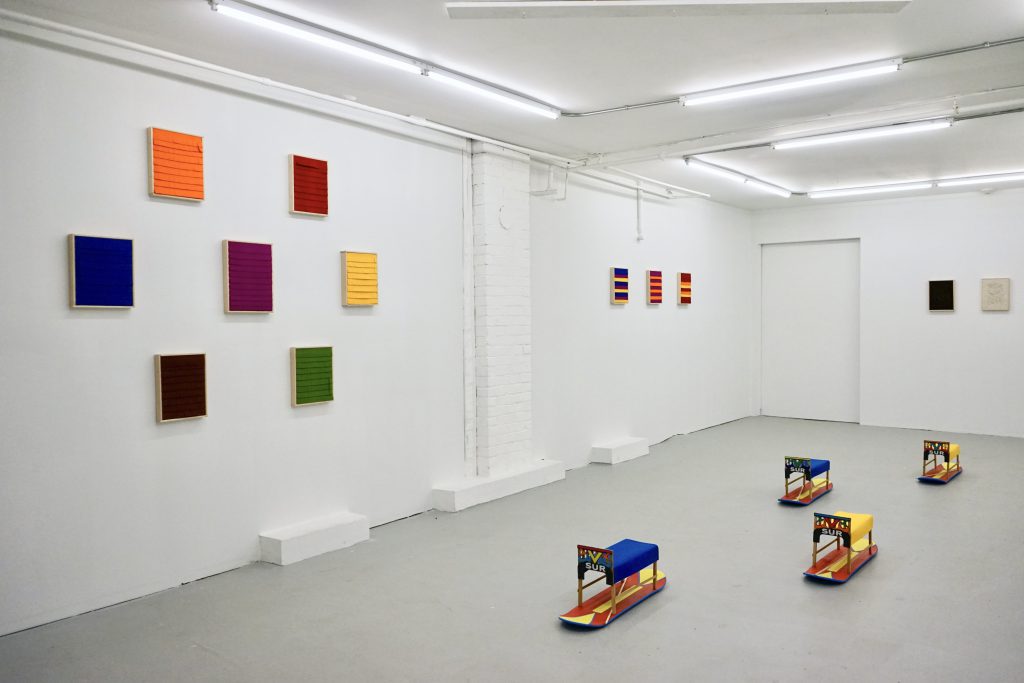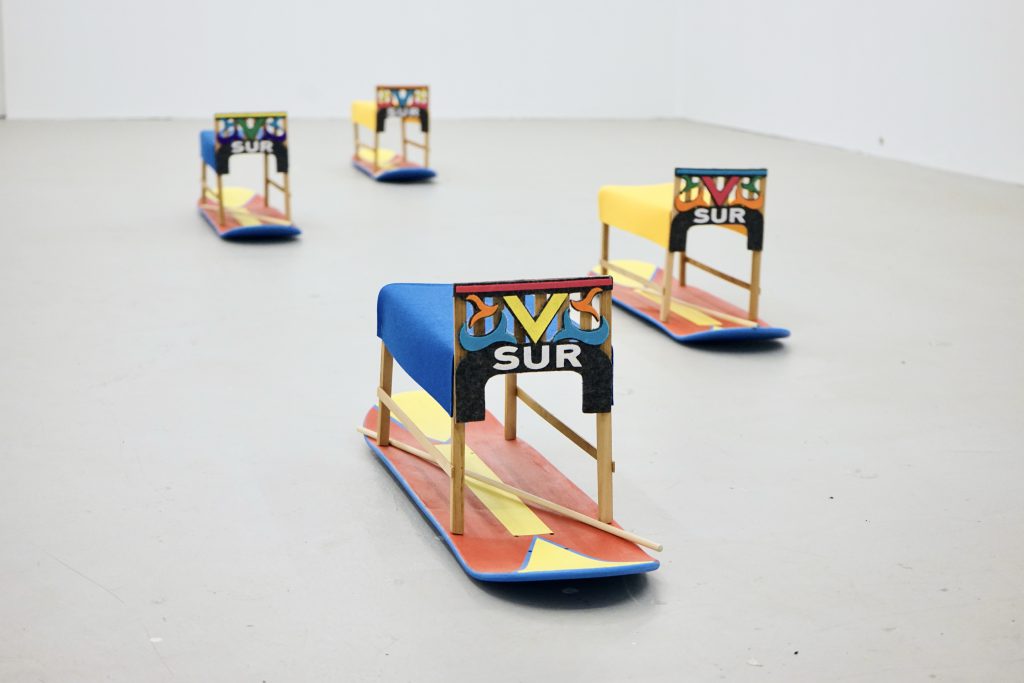La Cintura Cósmica del Sur (The Cosmic Waist of the South) at Fazakas Gallery
24 June 2022
By Angie Rico
In the Southeast borough of Xochimilco, Mexico, is an oasis of yore, solidified in popular tradition for city dwellers and tourists alike to visit the remaining lacustrine zones trapped among the sweltering chaos of Mexico City. The silent and robust trajineras are the transportation of choice for these terrains that offer one of the only remaining glimpses into Mexico City’s pre-Columbian era. Lined up in rows, these flat-bottomed boats float on the tranquil surface of the water, displaying adornments of papier-mâché and a name written in large letters on their front arches. They wait to be boarded by families, groups of friends, lovers, or mismatched strangers; music emanates from passing vessels as they ferry sightseers across the canals that are hundreds of years old. At one time, trajineras were the primary navigation tools that facilitated agricultural production, transportation, and political development for Indigenous civilizations in the basin of Mexico, with its extensive network of waterways. Colonization, along with modernization projects of the early 20th century, shrunk the waterways down to a system of canals and trajineras were re-adapted to entertain tourists and align with the modern rhetoric of the city.1 The appearance of trajineras in the popular imaginary is a result of this process.
In his latest exhibition, La Cintura Cósmica del Sur (The Cosmic Waist of the South), at Fazakas Gallery in Vancouver, Mexican artist Carlos Colín departs from this version of trajineras and transcends their geography of origin. In the Tanúyap Project Space, wherein experimental and conceptual exhibitions of both Indigenous and non-Indigenous contemporary works are shown in dialogue, small trajineras appear lined up in a dynamic formation that makes it seem as though they are arrested on their journey. In this series of works that re-imagine the boats, Colín adapts the flatness of skateboard decks without wheels to concoct a type of small-scale, hybrid trajinera with the characteristic colours and sunroofs of the vessels—which I’ll call “trajiboards,” in the resourceful spirit of Spanglish. Just like the full-scale versions found in Xochimilco, Colín’s models have not really retained their original purity, but nonetheless perpetuate an autochthonous identity. The other objects that share the space with the trajiboards are also stylistically familiar and unfamiliar. They jump out in their bright-colored fashion, drumming up conventionalized cultural genres at first glance. Simultaneously, they merge with modes external to these aesthetics, labouring upon a material heterogeneity that creates tensions and re-maps the objects’ own meanings and functions.

In the series Transtradición (Transtradition) (2020), the customary fringe that adorns piñatas is insinuated by layered rows of cut felt presented in nine-by-twelve inch frames. Iterations of these works in different color combinations hang staggered on the wall. Directly across from these pieces, hanging in a row, is a series of framed embroideries with varying titles that isolate figures from Mesoamerican codexes, or referencing pictographic traditions from that era. These two series, as well as the trajiboards, call upon larger traditions, techniques, and artifacts whose recognizable visual qualities are reworked and remixed as conceptual experimentations or studies in syncretism. Solidly placed at the discursive intersection of art and artifact, the frictions between tradition and contemporary art are used as jumping off points through which the historical, social, and economic relations intrinsic to the production, dissemination, consumption, or viewing of these cultural products begin to unveil themselves.
In his artist statement, Colín nods to the song “Canción con Todos,” by Argentine singer Mercedes Sosa, revealing that the exhibition title comes from the song’s opening line: “I walk outside / through the cosmic waist of the South.” Sosa’s song, a time-honored hymn of struggle and unity for South Americans, alludes to the inherent resistance of traversing through colonial inheritance, and its contradictions, by peoples across Latin America.
Alongside this direct reference, the exhibition’s preoccupation with developing abstract exercises in hybridity, coupled with the word “cosmic” inevitably invokes the spectre of the “cosmic race.” This term, coined by Mexican theorist José Vasconcelos, was extensively used during the early 20th century and was instrumental in solidifying a Mexican national identity. It emerged as a hopeful framework of racial and cultural hybridity, or mestizaje, that would dictate the political and social configuration of modern Mexican society. In a more prudent response to this concept, theorist Amos Nascimiento explains that the “cosmic race,” among other ideologies of mestizaje that have appeared across Latin America, were accepted without a critique of their historical connection to assimilation strategies.2 Hiding in plain sight, first during conquest and subsequently during nation-building, the potential of syncretism as a taciturn way to “adapt” has been used for more foreboding purposes, carrying with it unabashed models of eugenics and the total assimilation of Indigenous identities.

Weighed down by this historical burden, Colín makes use of objects to navigate a distinct moment in time, anchoring the references from an ever-changing cosmology tainted by long-term contact with the essentialist notions of ethnic selfhood. In most cases, the objects differ from their traditional form, but the subtleties reveal their origins and their potential to create new paradigms. Tlaquizcayotl de la Institución (The End of the Institution) (2020), an embroidery of what looks like a crumbling, burning building, uses Aztec/Mexica codexes and is titled with a mix of Náhuatl and Spanish, alluding to the metaphorical destruction of ideological state apparatuses. Using the simple graphism of Mesoamerican codexes, whose function was to showcase a determined social, political, and economic conjecture, invites the viewer to arrive at new postulations that comment on present-day reality. This piece maintains an atemporal dialogue with the works displayed in the main room of Fazakas Gallery: along with masks by Kwakwaka’wakw Northwest Coast artist and Chief Beau Dick, these works tell us of a recontextualization that welcomes a plurality of precolonial and postcolonial encounters.
Felt and wood are ubiquitous in the exhibition, invoking a certain craftsmanship further solidified by the presence of minimalist interventions throughout the collection of sculptural and framed objects. Focusing on the reduplication of techniques and the serial nature of the works, the artist clues us into his approaches to tradition and how this reveals the assumption that traditions more broadly are static and inert. Felt and wood, both strong, malleable, and rather accessible materials, point to the fact that traditions are shaped by the availability of resources. With this methodological and practical understanding, the exhibition probes the presupposed dichotomies of craft/technology, Western/Indigenous, modern/traditional, presenting objects that are resistant and non-fragile, and which refuse homogenous description. They are easily reproducible and adaptable to the mechanical reproduction of mass consumption masterfully co-opted by capitalist ingenuity.

Like chronicles of history, Colín’s works reveal how traditions and their histories have camouflaged themselves to survive. In the case of real trajineras, a process of acculturation was not the sole force that created hybrid discourses on the various rhetorical values of these vessels; their survival and pervasiveness also came by way of re-adaptation. In the throes of marginality, anything and everything becomes a commodifiable object, but also maintains the potential to be transgressive. La Cintura Cósmica del Sur gestates within idioms of the art marketplace and the context of so-called Canada, which has sustained oppressive and extractivist relations in and outside of its territory. Replicating some of their logic and principles, the exhibition creates self-representations intended to intervene in these capitalist and colonial modes of understanding.3 The works in the exhibition stand as prototypes or propositions for connection between complex metropolitan histories and cultural identities across Abya Yala. Colín’s trajiboards constitute an effort to return trajineras to their transitory impetus: from mere objects to a process no longer relegated to the rigid dogmas of “tradition.”
Proudly donning the word Sur (South) in large letters on their front arches, the trajiboards point toward the room’s exit—to their place of origin—as though guided by a compass of endemic cosmology beyond the confines of gallery walls, geographical borders, or nation-states. From this situated nexus of possibility, perhaps overpowered by the rigour of craftsmanship and material experimentalism, the diasporic subject comes through the crevices of the trajiboards and the rest of the works. Grounded in material conditions that are in perpetual flux, Colín translates experiences of displacement as a sentimental exchange, crafting poetic gestures of longing towards a transformative and generative communality.
- JM Banister and SG Widdifield, “The debut of ‘modern water’ in early 20th century Mexico City: The Xochimilco potable waterworks,” Journal of Historical Geography 1:46 (Oct 2014): pp. 36-52. https://doi.org/10.1016/j.jhg.2014.09.005
- Amos Nascimento, “Syncretism as a Form of Multicultural Politics: The Interlocation of African-Latin-American Identities in Brazil,” Latin American and Caribbean Ethnic Studies 7:2 (July 2012): pp. 115-136.
- Mary Louise Pratt, “Arts of the Contact Zone,” Profession (1991): pp. 33-40. www.jstor.org/stable/25595469
La Cintura Cósmica del Sur (The Cosmic Waist of the South) ran from April 10 – May 22, 2021 at Fazakas Gallery in Vancouver, BC.
Feature Image: Trajineras “Sur”, 2020 by Carlos Colín. Courtesy of Fazakas Gallery.



